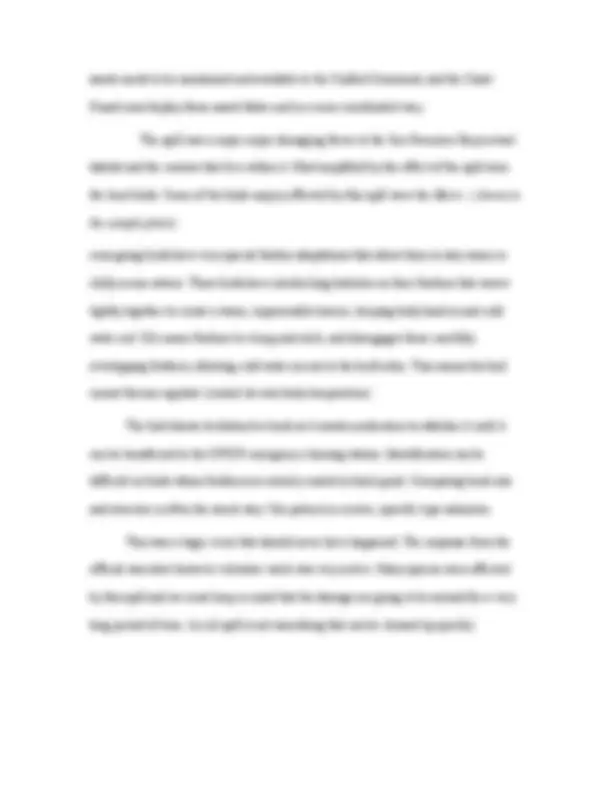



Study with the several resources on Docsity

Earn points by helping other students or get them with a premium plan


Prepare for your exams
Study with the several resources on Docsity

Earn points to download
Earn points by helping other students or get them with a premium plan
Community
Ask the community for help and clear up your study doubts
Discover the best universities in your country according to Docsity users
Free resources
Download our free guides on studying techniques, anxiety management strategies, and thesis advice from Docsity tutors
The costco busan oil spill that occurred in the san francisco bay in 2007, where 58,000 gallons of toxic oil spilled from a container ship that rammed the bay bridge. The document highlights the flaws in the response to the spill, including the slow reaction of the response team, insufficient containment boom, and lack of communication with local agencies. The document also discusses the impact of the spill on the ecosystem, particularly on local birds, and the need for improved spill prevention and response measures.
Typology: Assignments
1 / 3

This page cannot be seen from the preview
Don't miss anything!


Sarah Woods Ecology of the San Francisco Bay Crima B. Pogge 04/19- 09 The Costco Busan Oil Spill On November 7, 2007 58,00 gallons of toxic oil spilled into the San Francisco Bay from a container ship when it rammed the Bay Bridge at 8:27am. This spill was devastating and terrible and there were many flaws that were within this incident besides the actual spill. The response team was slow to react and according to testimony by the Marine Spill Response Corporation, the first clean up vessel with oil skimmers and containment boom did not arrive at the spill site until 9:50 a.m.! There were many local volunteers however once the response team set in motion and it was very apparent that there was much “bay love” that flowed from the people that called this place home. The state Office of Spill Prevention and Response (OSPR) requirements for containment and clean up response by the shipping industry need to be improved upon. For example, the minimum amount of containment boom required for deployment in the first hour after a spill for a vessel the size of the Costco Busan is 600 feet. However, the Busan was a 900 ft vessel and has much more boom than needed to surround the ship and the miles of fouled waters along the path of the ship. OSPR said they had a plan to deal with a wide variety of local contingencies including our bay winds and tides, but not for fog which is so prevalent in San Francisco Bay. Fog has been the excuse used by the Coast Guard and others for not knowing that the spill was much larger than the 10 barrels originally reported.
The decision was not well advised to immediately deploy the San Francisco fishing fleet in the clean-up effort. In one of my images it shows the patient receiving a Toxiban directly into its stomach to counteract the highly toxic oil coating its body. According to the testimony by the Pacific Coast Federation of Fishermen's Associations, the San Francisco fishing fleet, trained in boom deployment and oil clean up, asked the Coast Guard where they were needed in the clean up effort on the day of the spill. The fishing fleet was informed their valuable expertise wasn't needed and that they should volunteer for waterfowl clean up. The Coast Guard also failed to notify local agencies in a timely manner that the spill had occurred, that it was much larger than originally reported, and that tides and currents would send oil to coastal areas around the Bay and the Pacific coast in Marin and San Mateo Counties. These agencies could have brought immediately additional resources to the containment and clean up effort. In the case of some East Bay jurisdictions, there was never any contact from the Coast Guard, including agencies that control large swaths of Bay shoreline. Workers employed by the Marine Spill Response Corporation (MSRC), the nonprofit entity created by the oil and shipping industry to clean up spills, have said that 20 people were available in the early hours after the incident to deploy boom, but the actual need was 60 workers. Equipment, clean up vessels and crews retained by the oil refineries in Contra Costa County were never called upon by the U.S. Coast Guard, OSPR, or MSRC. Instead, teams were flown in from as far away as Louisiana and Florida to respond. Clearly, a list of available federal, state, local, and private containment and clean up